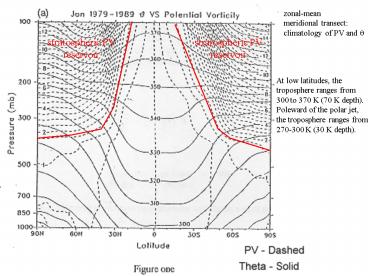stratospheric PV reservoir - PowerPoint PPT Presentation
1 / 15
Title:
stratospheric PV reservoir
Description:
Sketch a zonal transect of the general circulation of the atmosphere at about 25 N in July. ... Schematic zonal-mean cross section (after Palmen & Newton) ITCZ ... – PowerPoint PPT presentation
Number of Views:50
Avg rating:3.0/5.0
Title: stratospheric PV reservoir
1
zonal-mean meridional transect climatology of
PV and q
stratospheric PV reservoir
stratospheric PV reservoir
At low latitudes, the troposphere ranges from 300
to 370 K (70 K depth). Poleward of the polar jet,
the troposphere ranges from 270-300 K (30 K
depth).
2
(No Transcript)
3
Definition of PV
Abs vorticity x static stability
P is generally conserved (DP/Dt0) for adiabatic,
inviscid processes
friction (horizontally differential)
diabatic heating (vertically differential)
In a saturated environment Pe (equivalent PV) is
conserved
4
Rockies
Alps
flow over terrain assume Conservation of PV
flow partly around terrain PV (shear) creation
by differential friction (some PV advection from
the SS reservoir)
PVU
(Frobisher Schar 2001)
5
3. Daves cross section (25N)
Sketch a zonal transect of the general
circulation of the atmosphere at about 25ºN in
July. Include the mean circulation, some
isentropes (and label temperature anomalies as W
and C at the surface, at 5 km and at 15 km),
the tropopause, any subsidence inversions,
surface pressures (H and L), deep convection
(latent heating), any jet streams
6
V
4.
y
basic state
N
7
Wind _at_300 hPa, NH winter
5.
B
west coast transect
8
zonal wind speed
West Coast of N America
STJ
PFJ
9
section B, temperature
West Coast of N America
STJ
PFJ
10
Schematic zonal-mean cross section (after Palmen
Newton)
? ITCZ
11
6. Banded precipitation has been observed, and
you are to assess whether symmetric instability
occurred. List three different methods of
analysis.
- first check that the atmosphere is statically and
symmetrically stable! - Then ...
- 1. pick a transect across the bands and ...
- is the slope of the M lines lt slope of the q
lines? (i.e. - 2. (computational method if you have isentropic
data) IPVlt 0 - 3. (computational method for normal isobaric
data)
(use this last method in Q7 ...
12
7.
condition for SI
13
8.
? an increase in thermal vorticity must be
accompanied by a decrease in thickness, i.e.
cooling in the 1000-500 mb layer.
14
9.
15
(No Transcript)































